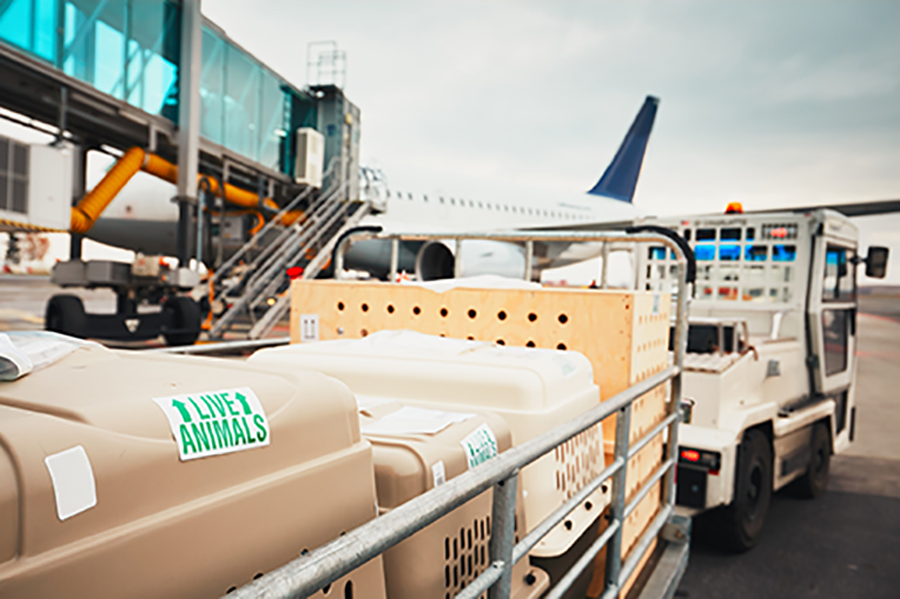How Many Pets Travel Per Year?
The US Department for Transportation states, over 2 million pets and other live animals are transported by air each year in the United States. And, although restrictions are put in place by federal and state governments, each airline has established its own policy. Meaning, it’s important for travelers to check before booking to ensure that their pet can travel, and how.
In 2015, a study showed that 62% of adult Americans owned a pet, and were planning on spending nearly $751 million on Valentine’s gifts for their cherished animals—showing pets are a main love in the American household, and frequently considered as “kids.” So, people shouldn’t be overly surprised when vacationers want to share the time away with their whole family, pets included.

Is It Safe For Pets To Travel In The Aircraft’s Hold?
During 2017, the Air Travel Consumer Report cited a total of 506,994 animals were transported and 40 incidents recorded, or 0.008%. It’s worth highlighting that of the 17 airlines included in the report, which transport animals, only four reported death, injury or loss of animals during the whole of 2017.
It’s wise to have a health check for your pet, before making any travel arrangements. Of the 40 incidents reported in the 2017, some of the fatalities in transit occured due to underlying health problems.
Owning a TSA approved case for your pet will help dramatically—not only with check-in, but also while in the air. Most airlines (if not all) specify that you must transport your pet in an approved carrier to be allowed to fly. Approved crates have been through rigorous testing for comfort, ventilation, safety and robustness, so you can worry less about how your pet is coping with the flight.
It’s shown to be good for your fur baby’s health and psyche to check up on them during your flight. Talk with them so they hear a familiar voice. If circumstances permit, put the carrier on your lap for a while and look through the vents while communicating with them.

How Do I Book My Pet A Plane Ticket?
You’ve decided on your destination, taken your precious to a licensed veterinarian for a complete check up, and found a good TSA approved pet carrier; now, how exactly do you go about booking a ticket for your furry (or not so furry) friend?
Some airlines don’t allow pets to travel on board their aircraft at all, others only allow animals to travel in the cargo hold, and some allow side seat options pending certain criteria. When you’re looking to book flights, you should always ensure you’ve checked the carrier’s pet travel policy prior to booking—you don’t want to secure your ticket before you’ve checked your pet can actually travel with you. Getting refunds is difficult at best. And, double check for any of those annoying ‘ifs’ and ‘buts,’ which have a tendency to come back and bite you. For example, in United’s new pet policy, dogs or cats with ‘short’ or ‘snub’ noses, as well as strong-jawed breeds have been excluded “out of concern for higher adverse health risks.”
United, as explained in their PetSafe Travel Planning, no longer allow animal reservations flying to and from desert locations in Tucson, Phoenix, Las Vegas and Palm Springs between May 1 and September 30 due to the extreme heat conditions.

Do All Countries Have The Same Pet Travel Policies?
Understandably, there’s a big difference between travelling with animals domestically and internationally. You may be used to taking the usual documents and hopping on a plane with little Fido from Seattle to Green Bay, but travelling overseas needs a bit more preparation than that.
If you’re flying to the UK, your pet can’t travel in the cabin with you—unless of course it’s a service or emotional support animal. There are ways around this. You could fly in to Paris, take a train to Calais, then jump on one of the ferries which frequently run between there and Dover in the south of England.
All EU countries require your pet to have a microchip, and all documentation, which supports the microchip number, in order to enter. Be sure the brand of microchip your pet has meets the requirements of the country you are entering.
If you live in the EU, all pets travelling with you should be holders of the blue “Pet Passport,” which makes keeping on top of documentation a lot easier. The Pet Passport records information such as owners’ details, pet description, vaccination records, as well as rabies blood tests and canine tapeworm results and treatments.
What Should My Pre-Flight Checklist Look Like?
Preflight checklists ultimately depends on where you’re flying to or from, the breed of your furry child, as well as airline policies. Do they have stricter rules than you’ve encountered before?
- Prior to purchasing tickets, speak with your airline, or do an online search, to learn about their Pet Travel policy.
- Check which tests need to be carried out.
- Check which documentation you’ll need to bring with you for entry to your destination (especially if international).
- Make sure your pet insurance is still valid before you travel with your pet.
- If your pet can travel in the cabin with you, ensure your cabin bag is TSA (or other airline safe) approved.
- Age limits can be imposed, make sure your pet is within these limits during the dates of travel.

